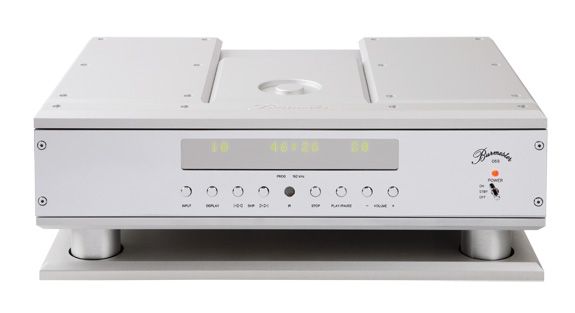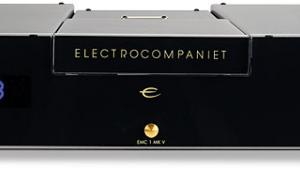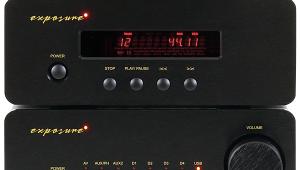Burmester Reference 069 (£34,135)

Attend any major international hi-fi fair and Burmester Audiosysteme is sure to be wowing the audiophile crowd with its range of opulent, chrome-finished audio exotica. Alongside the likes of Dynaudio and Clearaudio, Burmester is one of Germany’s premier high-end audio marques. It’s a thriving company, its brand name revered among the audio cognoscenti around the globe. Such is its stature in its home market it was even invited to develop luxurious in-car sound systems for Porsche and Bugatti. Yet the company’s specialised audio products have only been available sporadically in the UK over the years.
Burmester is looking to change all that during 2012, appointing a very select number of British hi-fi dealers with adequately grand listening rooms for demonstrating such high-end components. So while this lavish two-box 069 CD player is far from brand new – it was launched four years ago, in fact – only now is it available for purchase this side of the Channel. Here at HFN we jumped at the chance to get our hands on it. Yes please!
TIMELESS PRESENTATION
Even Burmester’s ‘entry-level’ components (its Rondo Line range, soon to be replaced by new models, we understand) are pretty swish, priced at around £4000 or so. Next come the company’s Classic Line products, the Top Line and finally the cost-no-object Reference Line. This, then, represents Burmester’s crème de la crème: the best CD player it currently makes, designed for partnering its circa £55k ‘Reference’ 808 MK5 and 909 MK5 pre/power amplifier combination. This is hi-fi for the privileged: bankers, premier league footballers, A-list celebrities and NHS hospital managers should form an orderly queue…
In its promotional literature Burmester puts considerable emphasis on the timelessness of its chrome-finished designs, making reference to Bauhaus-inspired furniture from the 1930s and classic cars of bygone days. ‘Art for the Ear’ is the company’s marketing slogan, citing that the polished chrome fascias used for all its products affords them high durability as well as making them beautiful objects to display in one’s living room.
Of course, I found myself constantly wanting to polish away inevitable finger marks. And while the layout of the CD player’s control buttons is delightfully logical, that mirror effect makes the legends difficult to see in low lighting. Certainly the 069 wouldn’t look out of place either in a stately home or a contemporarily furnished Penthouse apartment with floor-to-ceiling windows and views to die for. So Burmester is correct. It is timeless.
If you’re feeling the pinch during these economically difficult times, the 069 is available as a single-box machine with built-in power supply, priced £26,735. But the one we have here is the go-for-broke version, with an outboard supply that connects to the player via a substantial umbilical cable. Build quality is nothing short of fabulous, the player and its power supply each housed in enclosures formed of thick aluminium and weighing 25kg a piece. The components’ chunky feet are turned in such a way that they represent inverted cones at their bases. Both player and power unit are supplied with separate base plates – weighty slabs of aluminium with chamfered edges to act as plinths. These have circular recesses into which the components’ feet locate. But the feet don’t sit directly on the aluminium plates. Instead they rest on ‘damping discs’ formed of carbon fibre, designed to provide a further degree of vibration isolation.
BELT DRIVE
As with all but the company’s entry-level CD player, the 069 is a manual top loader that eschews a traditional direct drive motor, employing instead Burmester’s elaborate belt-driven disc transport mechanism with precision bearing [see boxout]. It’s housed in a ‘capsule block’ isolation chamber designed to afford immunity from the outside world. Sliding open the top cover to expose the disc-loading bay is a sensual experience, the lid (also milled from aluminium, of course) gliding smoothly back and forth with delightful precision. A clamp is provided to sit on top of the CD, much like a LP record weight in miniature.
The 069 features three digital inputs (two RCA coaxial and one optical Toslink) as well as a balanced analogue input (XLR). The player has selectable volume control – with volume up/down keys on both the front panel and remote control handset – so it’s perfectly possible to dispense with a preamplifier and run the 069 directly into a power amp or active speakers.
Whether the player’s analogue outputs are to be fixed or variable is determined via the 069’s initial set-up menu. Here you can also choose the player’s initial volume setting on powering it up (via ‘variable output’), whether or not you’d like the machine to begin automatically playing a CD when it’s turned on (rather than it simply reading a disc’s TOC), and you can set the 069’s track intro-scan feature from 1-20 seconds. Other options include analogue input level adjustment, a –10dB output gain setting, enabling the handset to switch inputs, and activating the player’s ‘library’ feature. When using programme play the 069 can memorise up to 99 CDs and store compiled programmes in its library.
Before reaching the digital-to-analogue conversion stage, all digital signals – whether from the internal disc drive or external sources – are upsampled to 24-bit/96kHz or 24-bit/192kHz by the 069’s on-board sample rate converter. Selection of either is via the Audio key on the handset, an LED in the player’s display indicating 192kHz operation.
The output stage employs Burmester’s proprietary ‘X-Amp 2’ modules, balanced operational amplifiers assembled using selected discrete components and featuring integrated DC offset compensation. There are no capacitors in the signal path. Says the company: ‘There is no influence on the music signal resulting from phase shift or frequency roll-off. Moreover the usual discussion concerning which capacitors sound the best can be omitted: the best sound is achieved without any capacitors at all!’
EFFORTLESS PERFORMANCE
As you might imagine, this exquisitely crafted two-box behemoth draws oohs and aahs even before it’s powered up and playing music. So how does it sound, given that it costs more than many audiophiles’ complete systems? (High-end ones at that!) Well, within moments of spinning up my first disc I could hear that the 069 is a sumptuous and creamy-sounding player. It also sounds effortless and relaxed.
Connected to one of the balanced inputs of my Levinson No.383 integrated amplifier using Nordost Tyr interconnects – and with the Burmester’s volume control set to ‘46’ [see Lab Report] – I settled into a performance of Aaron Copland’s An Outdoor Overture by the Pacific Symphony Orchestra under Keith Clark [Reference Recordings RR-22CD]. The 069 furnished a holographic perspective of the concert hall with tremendous image depth. It appeared to put the listener at the rear of the stalls rather than up-front and personal, adding to the sense of ‘believability’. Professor Keith O Johnson’s analogue recording from 1982 sounded beautifully balanced, the strings sweet and luscious, the percussion sparkling. And the wallop of the timpani almost knocked me off the sofa, as the dynamic impact took me by surprise.Switching between 96 and 192kHz up-sampling was interesting. I left the 069 set to 96kHz after determining that the image appeared better focused.
The 069 delivers immense dynamic swings when the need arises while seeming to remain completely within its comfort zone. As already noted, no matter what happened in the music it always appeared calm and relaxed. Bass was a touch fulsome in my system (my huge Townshend speakers are far from challenged in the bass department) so with the 069 the overall balance was a tad too thick at times. But I wasn’t complaining, relishing the unruffled composure the Burmester brought even to full-on rock recordings of limited fidelity.
That aforementioned depth-of-sound-field, observed when listening to the Copland overture, produced magic when playing recordings of rock groups live in concert. Released only last year, a triple CD set [ZPCD99] of Frank Zappa’s 1978 band performing in London’s Hammersmith Odeon (ahem, the ‘HMV Apollo’ these days) sounded tangibly real in its perspective and scale. The drums via the PA could be heard to resonate throughout the majestic 3500-seat Art Deco auditorium, the cymbals sizzling and clearly ‘gated’ by whoever was sitting at the sound desk at the time.
The 069 might not appear to be highly detailed, such is its tranquil, unforced demeanour; however it allows you to ‘listen in’ deeply and observe fine detail buried in recordings. Patrick O’Hearn’s languid, fretless bass formed a grumbling foundation during the sinister ‘The Torture Never Stops’, the band musicians spread across the stage in believable fashion within a solid image. Progressions from barely audible pianissimos to thunderous fortissimos remained coherent throughout the performance, the music bubbling with anticipatory tension. Did I feel as if I was there, in the audience? Actually, studying the sleeve notes and seeing the recording dates, I believe I probably was… but that was a lifetime ago.
The Burmester’s ‘terribly civilised’ deportment paid dividends when playing the jangling ‘Grounds For Divorce’ from Elbow’s The Seldom Seen Kid [Polydor 1764098]. This 2008 release is a rollickin’ stomper but challenging to an audiophile’s sensibilities, the sound hard, spitty and ragged. It would be an exaggeration to say that the 069 made it sound wonderful, nevertheless it did make it listenable. And once again the player’s strong bass delivery served to add drama, the cavernous drum-kicks during ‘Grounds For Divorce’ being reminiscent of the White Stripes’ typically hollow, reverberant sound productions. Was the drum recorded in a large room? Or is the reverb a purely electronic creation? Who knows? Whatever, the drum kit appeared to be positioned wa-ay back from the plane of my loudspeakers, prompting the adage ‘it sounded as if the drummer was out in the street…’. Marvellous!
BACK TO THE PAWNSHOP
Returning to some traditional audiophile fare I spun up Jazz At The Pawnshop [Proprius PRSACD 7879] for the first time in ages. Again, Burmester’s 069 delivered a wonderfully atmospheric sound image that you felt you could walk into, the clinking of glasses and gentle hubbub of the audience on this classic recording all adding to the feeling of being there, mingling with the patrons of the jazz club. The recreation of the acoustic space was enchanting and the sound of the instruments vibrant and alive with the launch of Gershwin’s ‘Lady Be Good’, the performance remaining infectiously rhythmic, musical and easy on the ear.
VERDICT
You don’t have to spend thousands on a compact disc player to enjoy wonderful sound. But if you’ve got it – and want to flaunt it – this Burmester 069 makes a bold design statement and sounds quite magnificent. It delivers powerful, deep bass, a creamy and richly-textured midband, and is as smooth as silk at the top end. It’s delicious stuff for the well-heeled audiophile and luxurious indeed.
Originally published in the January 2012 issue

























































